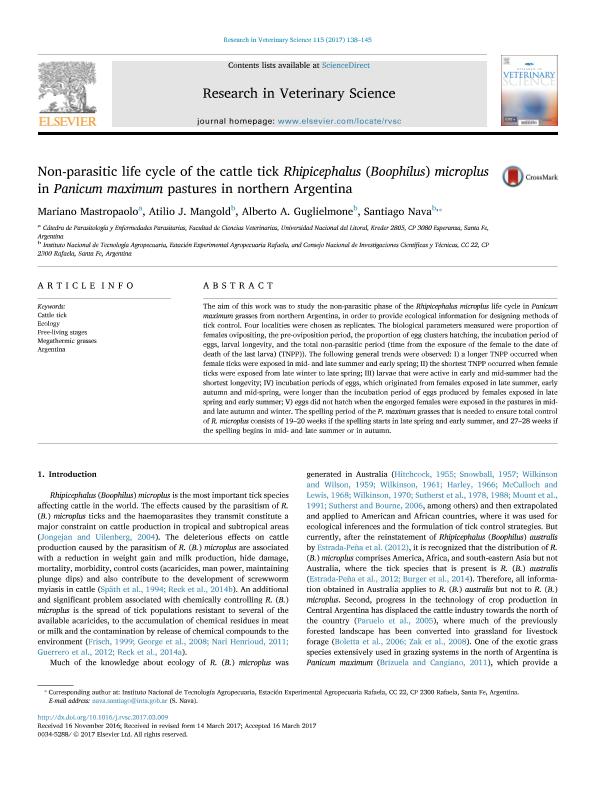Mostrar el registro sencillo del ítem
dc.contributor.author
Mastropaolo, Mariano

dc.contributor.author
Mangold, Atilio Jose

dc.contributor.author
Guglielmone, Alberto Alejandro

dc.contributor.author
Nava, Santiago

dc.date.available
2018-09-07T15:03:08Z
dc.date.issued
2017-12
dc.identifier.citation
Mastropaolo, Mariano; Mangold, Atilio Jose; Guglielmone, Alberto Alejandro; Nava, Santiago; Non-parasitic life cycle of the cattle tick Rhipicephalus (Boophilus) microplus in Panicum maximum pastures in northern Argentina; Elsevier; Research in Veterinary Science; 115; 12-2017; 138-145
dc.identifier.issn
0034-5288
dc.identifier.uri
http://hdl.handle.net/11336/58687
dc.description.abstract
The aim of this work was to study the non-parasitic phase of the Rhipicephalus microplus life cycle in Panicum maximum grasses from northern Argentina, in order to provide ecological information for designing methods of tick control. Four localities were chosen as replicates. The biological parameters measured were proportion of females ovipositing, the pre-oviposition period, the proportion of egg clusters hatching, the incubation period of eggs, larval longevity, and the total non-parasitic period (time from the exposure of the female to the date of death of the last larva) (TNPP)). The following general trends were observed: I) a longer TNPP occurred when female ticks were exposed in mid- and late summer and early spring; II) the shortest TNPP occurred when female ticks were exposed from late winter to late spring; III) larvae that were active in early and mid-summer had the shortest longevity; IV) incubation periods of eggs, which originated from females exposed in late summer, early autumn and mid-spring, were longer than the incubation period of eggs produced by females exposed in late spring and early summer; V) eggs did not hatch when the engorged females were exposed in the pastures in mid- and late autumn and winter. The spelling period of the P. maximum grasses that is needed to ensure total control of R. microplus consists of 19–20 weeks if the spelling starts in late spring and early summer, and 27–28 weeks if the spelling begins in mid- and late summer or in autumn.
dc.format
application/pdf
dc.language.iso
eng
dc.publisher
Elsevier

dc.rights
info:eu-repo/semantics/openAccess
dc.rights.uri
https://creativecommons.org/licenses/by-nc-sa/2.5/ar/
dc.subject
Argentina
dc.subject
Cattle Tick
dc.subject
Ecology
dc.subject
Free-Living Stages
dc.subject
Megathermic Grasses
dc.title
Non-parasitic life cycle of the cattle tick Rhipicephalus (Boophilus) microplus in Panicum maximum pastures in northern Argentina
dc.type
info:eu-repo/semantics/article
dc.type
info:ar-repo/semantics/artículo
dc.type
info:eu-repo/semantics/publishedVersion
dc.date.updated
2018-09-06T18:43:24Z
dc.journal.volume
115
dc.journal.pagination
138-145
dc.journal.pais
Países Bajos

dc.journal.ciudad
Amsterdam
dc.description.fil
Fil: Mastropaolo, Mariano. Consejo Nacional de Investigaciones Científicas y Técnicas; Argentina. Universidad Nacional del Litoral. Facultad de Ciencias Veterinarias; Argentina
dc.description.fil
Fil: Mangold, Atilio Jose. Consejo Nacional de Investigaciones Científicas y Técnicas; Argentina. Instituto Nacional de Tecnología Agropecuaria. Centro Regional Santa Fe. Estación Experimental Agropecuaria Rafaela; Argentina
dc.description.fil
Fil: Guglielmone, Alberto Alejandro. Consejo Nacional de Investigaciones Científicas y Técnicas; Argentina. Instituto Nacional de Tecnología Agropecuaria. Centro Regional Santa Fe. Estación Experimental Agropecuaria Rafaela; Argentina
dc.description.fil
Fil: Nava, Santiago. Consejo Nacional de Investigaciones Científicas y Técnicas; Argentina. Instituto Nacional de Tecnología Agropecuaria. Centro Regional Santa Fe. Estación Experimental Agropecuaria Rafaela; Argentina
dc.journal.title
Research in Veterinary Science

dc.relation.alternativeid
info:eu-repo/semantics/altIdentifier/doi/https://dx.doi.org/10.1016/j.rvsc.2017.03.009
dc.relation.alternativeid
info:eu-repo/semantics/altIdentifier/url/https://www.sciencedirect.com/science/article/pii/S0034528816306300
Archivos asociados
